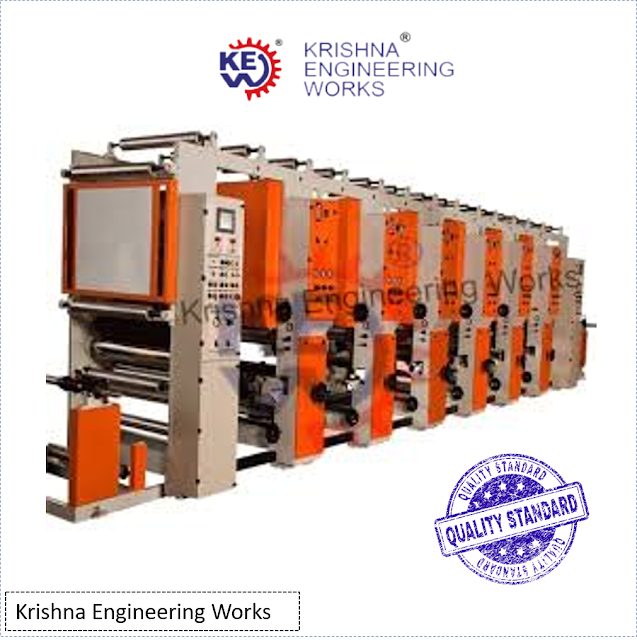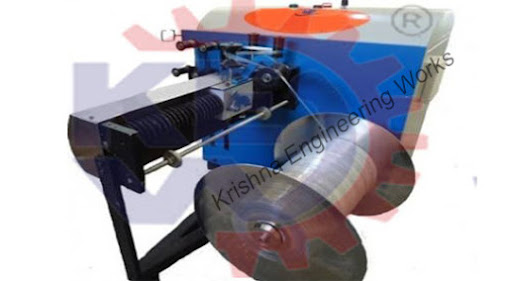KNOWLEDGE OF ROTOGRAVURE PRINTING MACHINE
KrishnaEngineering Works is a company based in India that specializes in the manufacturing and exporting of a range of industrial equipment, including rotogravure printing machines. This company offers a variety of models of rotogravure printing machines, including standard and custom-designed machines to meet specific customer requirements. Some of the key features of rotogravure printing machines include:
High-precision engraving technology: We have used advanced engraving technology to ensure that the cylinders used in the printing machines are accurately engraved with the desired image.
Customizable configurations: Rotogravure offers customizable configurations for printing machines, allowing customers to choose the number of colors, printing width and other parameters to suit their needs.
Robust
construction: The printing machines manufactured by are made using
high-quality materials and are designed to withstand the rigors of heavy use in
industrial applications.
Advanced
control systems: rotogravure printing machines feature advanced control
systems that allow operators to precisely control the printing process and make
adjustments on-the-fly to ensure high-quality prints.
Easy
to use: Despite their advanced features, the printing machines manufactured are designed to be easy to use and maintain with user-friendly interfaces and simple maintenance procedures.
Overall, KEW is a reputable manufacturer of high-quality
rotogravure printing machines that are used by businesses around the world for
a variety of industrial applications.
What is the Rotogravure Printing Machine?
Rotogravure
printing is a type of intaglio printing process used for high-volume printing
of magazines, newspapers, packaging, and decorative prints. The process
involves etching the image onto a cylinder (made of copper or steel), which is
then coated with ink. The ink is then transferred onto the paper or other
substrate under pressure, creating a high-quality print with sharp, clear
images and rich, vibrant colors.
The
rotogravure printing machine consists of several key components, including a
series of cylinders, an ink system, a doctor blade, and a dryer. The printing
cylinders are engraved with the image to be printed, and the ink is applied to
the cylinders using an ink system. As the cylinder rotates, the doctor blade
removes any excess ink, leaving only the ink that is trapped in the engraved
cells. The paper or other substrate is then pressed against the cylinder, and
the ink is transferred onto the substrate.
This Machine is known for its high speed, consistent quality, and ability to print on a wide variety of substrates. It is commonly used for printing high-quality images on paper, plastic, and metal surfaces, and is particularly well-suited for printing large quantities of materials.
Rotogravure printing machine process
The
rotogravure printing machine process can be broken down into several steps:
Image
preparation: The first step in the process is to prepare the image that will be
printed. This may involve designing the image, creating a digital file, and
converting the file to a format that can be used by the printing machine.
Cylinder
preparation: The next step is to prepare the cylinder that will be used to
transfer the image onto the substrate. The cylinder is typically made of copper
or steel and is engraved with the image using a diamond-tipped stylus. The
depth and spacing of the engraved cells determine the amount of ink that will
be transferred onto the substrate.
Ink
preparation: The ink used in rotogravure printing is typically a solvent-based
or water-based ink that is formulated to adhere to the substrate and dry
quickly. The ink is mixed and then loaded into an ink system that will apply
the ink to the engraved cylinder.
Printing:
Once the cylinder is loaded with ink, the substrate (such as paper or plastic
film) is fed through the machine and pressed against the cylinder. The pressure
forces the ink out of the engraved cells and onto the substrate, creating a
high-quality print. The process is repeated for each color in the image, with
each color requiring a separate cylinder.
Drying:
After the ink is applied, the substrate is passed through a dryer to evaporate
any solvents or water and ensure that the ink adheres to the substrate.
Finishing: Depending on the application, the printed substrate may undergo additional processing steps such as laminating, cutting, or folding before it is ready for use.
Specifications of rotogravure printing
machines:
Web
Width: 20" to 80"
Number
of colors: 1 - 8 colors
Web
Roller: Aluminum Roller or Steel Roller
Web
roller: Steel rollers Aluminum rollers or
Machine
speed: Up to 250 m/min
Reel
diameter: 1000 mm
Cylinder
Dia: 100 mm to 800 mm
Unwind
shaft: Air shaft, tapper cone with solid shaft
Printing
material: aluminum foil, Film, Bopp, poly, paper, aluminum foil, pet,
polyester, metalized film, etc.
Infeed
unit: Synchronized control
Wed
Width: 500 mm to 2050 mm
Unwind/rewind
Reel Dia: 1000 mm
Film
Thickness: 6 Micron to 300 Micron
Paper
Thickness: 20 Gsm to 300 Gsm
Printing Unit:
Cylinder:
The cylinder is the heart of the printing unit. It is typically made of copper
or steel and is engraved with tiny cells that hold the ink. The depth and
spacing of the cells determine the amount of ink that will be transferred onto
the substrate.
Ink
system: The ink system is responsible for applying ink to the cylinder. It
typically consists of a series of rollers that distribute the ink evenly across
the cylinder's surface.
Doctor
blade: The doctor blade is a thin, flexible strip of metal that scrapes off any
excess ink from the cylinder's surface. This helps to ensure that only the ink
in the engraved cells is transferred onto the substrate.
Substrate
feed: The substrate feed is the mechanism that moves the substrate (such as
paper or plastic film) through the printing machine. It is typically a series
of rollers that apply pressure to the substrate, pressing it against the
cylinder and transferring the ink.
Dryer:
The dryer is used to evaporate any solvents or water from the ink and substrate
after printing. This helps to ensure that the ink adheres to the substrate and
does not smudge or smear.
Control system: The control system is the brain of the printing unit. It manages all the components and ensures that the printing process is carried out accurately and efficiently.
In
conclusion, a rotogravure printing is a specialized industrial machine
that uses engraved cylinders to transfer ink onto a substrate, typically for
printing images or designs. The printing process is highly accurate and capable
of producing high-quality prints at high speeds and volumes. The machines are
used in a variety of industries, including packaging, label printing, and
publishing. For more information visit our website: www.krishnaengineeringworks.com or email: kewinquiry@gmail.com.



Comments
Post a Comment